
These four individuals are whom Luciana Jonkman referred to as the "forage family" during her presentation at the recent U.S. Custom Harvesters Convention in Omaha, Neb.
Jonkman, a dairy nutritionist based in California, also operates a custom harvesting business with her husband. She offered advice on how to harvest high-quality corn silage while at the same time keeping the frustration level of the forage family to a minimum.
"Make an effort to have a mutual understanding of what winning looks like for everyone involved. Then keep score," said Jonkman. To accomplish this task, the forage family — farmer, nutritionist, veterinarian and harvester — need to sit down before harvest and agree on attainable and realistic corn silage harvesting goals. Each member needs to understand the capabilities and limitations of the system, including the harvesting machine.
Jonkman acknowledged that there are situations where tensions run high between forage family members, and sometimes the nutritionist is the source of that tension. "Corn silage is a big part of the ration, so it has to be consistent to maintain a healthy, functioning rumen," said Jonkman. "If there's a ration or performance problem, corn silage is often the first place we look."
The nutritionist suggested making defined goals and realize that not all of them may be met every year because of uncontrollable factors like weather. Jonkman then explained what she likes to set as corn silage goals for her clients.
"First, I want to see a kernel processing score, or KPS, of 70 or higher," said Jonkman. "We have to marry the rumen bugs to the starch, and the way we do that is with proper kernel processing. Just nicking or crushing the kernel is no longer acceptable. If we do it right, the stalk should be sliced and torn and the kernel should be destroyed. Any properly set machine is capable of doing this," she explained.
Because conditions change, Jonkman noted the importance of checking processor performance through harvest. "I don't like to assess silage in my hand," she said. Rather, she prefers using a water float test whereby the forage stover floats on top and the smaller kernel pieces sink to the bottom.
Next on Jonkman's list of goals is a 17 to 21 millimeter theoretical length of cut. "We want to strive for ripped or torn leaves and stalks that have an optimal surface area for digestion," she noted.
From a field-harvesting standpoint, Jonkman's final goal is corn silage at about 33 percent dry matter.
The nutritionist also sets some storage goals and recommendations. She wants to see bunkers packed to at least 17 pounds of dry matter per cubic foot. "If you do the packing along with the harvesting, measure the density so you can use it as a promotional tool for your custom business," said Jonkman. "If you're not hitting that goal, then figure out why. Maybe your pack tractor driver is not the best person for that job."
Though most custom harvesters are not responsible for covering bunkers or stacks, Jonkman shared her recommendation of using an oxygen barrier material along with an outer plastic cover.
"Science has improved our understanding of the cow, the corn and the equipment," said Jonkman. Because there's more to know, each forage family member needs to understand the other's perspective and have a basic understanding of the other's science. By doing so, the tension and frustration that often accompanies the corn silage harvest can be dramatically reduced.
